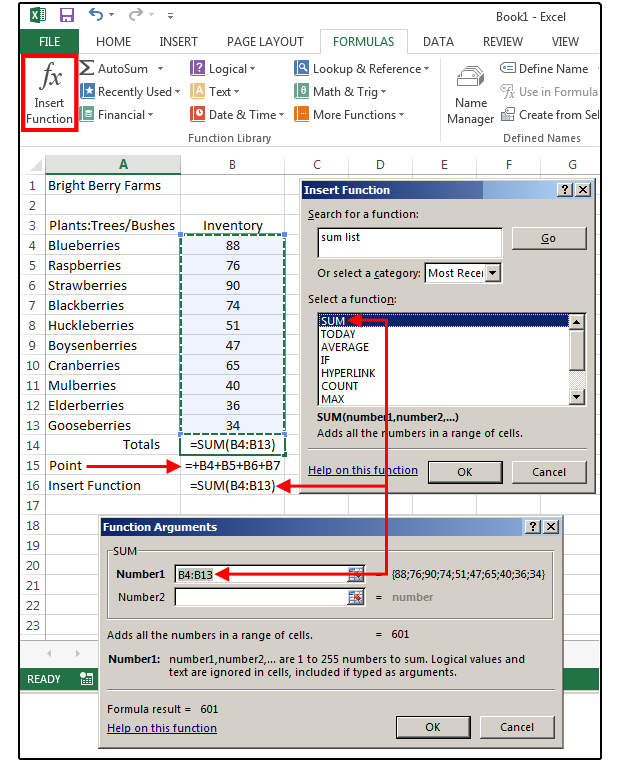102 Microsoft Excel Formulas & Functions Cheat Sheet [Free Download]
※ Download: Excel formulas
Selecting a Formula from One of the Groups in Formula Tab The option is for those who want to delve into their favorite functions quickly. Tired of manually entering data that follows a pattern across a bunch of cells? The TRIM formula removes that extra space. But I say at least learn these 102 Excel formulas; you will be a superuser of Excel.
:max_bytes(150000):strip_icc()/excel-subtract-numbers-formula-57b5d5e95f9b58b5c2dfa8f8.jpg?full=1)
Just want to select everything in a particular column of row? Functions: The returns the value of pi: 3.

Basic Excel Formulas - Constants: Numbers or text values entered directly into a formula, such as 2. In the example above, we were looking to identify any duplicate salaries within the selected range, and formatted the duplicate cells in yellow.

Note: Formulas in Excel always begin with the equal sign. For example, — for subtraction. The result of the calculation appears in the cell with the formula. Download our Formulas tutorial workbook We've put together a that you can download. Formulas in-depth You can browse through the individual sections below to learn more about specific formula elements. A formula can also contain any or all of the following: functions, references, operators, and constants. Parts of a formula 1. Functions: The returns the value of pi: 3. References: A2 returns the value in cell A2. Constants: Numbers or text values entered directly into a formula, such as 2. A constant is a value that is not calculated; it always stays the same. An expression or a value resulting from an expression is not a constant. In general, it's best to place constants in individual cells where they can be easily changed if needed, then reference those cells in formulas. A reference identifies a cell or a range of cells on a worksheet, and tells Excel where to look for the values or data you want to use in a formula. You can use references to use data contained in different parts of a worksheet in one formula or use the value from one cell in several formulas. You can also refer to cells on other sheets in the same workbook, and to other workbooks. References to cells in other workbooks are called links or external references. These letters and numbers are called row and column headings. To refer to a cell, enter the column letter followed by the row number. For example, B2 refers to the cell at the intersection of column B and row 2. Refers to the worksheet named Marketing 2. Refers to the range of cells from B1 to B10 3. If the position of the cell that contains the formula changes, the reference is changed. If you copy or fill the formula across rows or down columns, the reference automatically adjusts. By default, new formulas use relative references. If the position of the cell that contains the formula changes, the absolute reference remains the same. If you copy or fill the formula across rows or down columns, the absolute reference does not adjust. By default, new formulas use relative references, so you may need to switch them to absolute references. If the position of the cell that contains the formula changes, the relative reference is changed, and the absolute reference does not change. If you copy or fill the formula across rows or down columns, the relative reference automatically adjusts, and the absolute reference does not adjust. A 3-D reference includes the cell or range reference, preceded by a range of worksheet names. Excel uses any worksheets stored between the starting and ending names of the reference. B5 adds all the values contained in cell B5 on all the worksheets between and including Sheet 2 and Sheet 13. S, STDEVA, STDEVPA, VAR. S, VARA, and VARPA. What occurs when you move, copy, insert, or delete worksheets The following examples explain what happens when you move, copy, insert, or delete worksheets that are included in a 3-D reference. A2:A5 to add cells A2 through A5 on worksheets 2 through 6. The R1C1 reference style is useful for computing row and column positions in macros. For example, if you record a command, such as clicking the AutoSum button to insert a formula that adds a range of cells, Excel records the formula by using R1C1 style, not A1 style, references. You can turn the R1C1 reference style on or off by setting or clearing the R1C1 reference style check box under the Working with formulas section in the Formulas category of the Options dialog box. To display this dialog box, click the File tab. You can always ask an expert in the , get support in the , or suggest a new feature or improvement on.
G40 has a formula that sometimes populates from a excel formulas worksheet. This will recognize your formula as an array, wrapping your formula in brace characters and successfully returning your product of both ranges combined. He teaches on Udemy. People say if you learn 20-25 formulas, you can master Microsoft Excel. You used VLOOKUP to put the revenue next to the name. How do you find the combined value of a large group of cells. Numerical arrays are a useful way to perform more than one formula at the same time in a single cell so you can see one final sum, difference, product, or quotient. I am using below excel formulas and its working when A11 is same with B6. S, VARA, and VARPA. Once this is complete, Excel will add and subtract the remainder of your formula. To display this dialog box, click the File tab.



